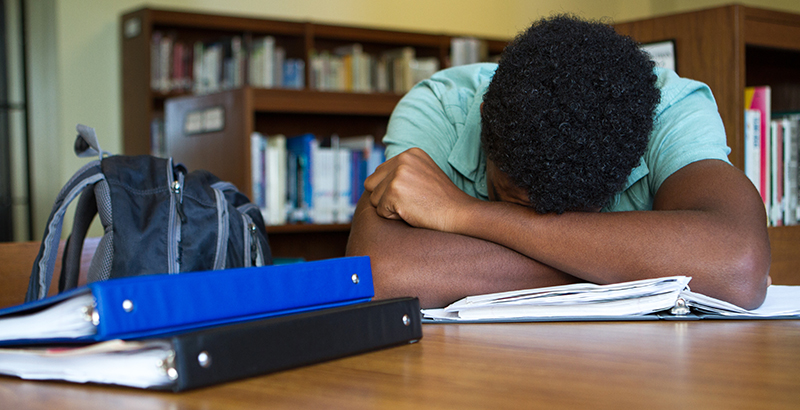Albright: Physical Health Is Only Part of What Makes a School Safe. 4 Ways to Include Student Mental Health in Reopening Plans

Get essential education news and commentary delivered straight to your inbox. Sign up here for The 74’s daily newsletter.
As vaccine distribution picks up pace across the country and governors join President Joe Biden’s push for schools to return to in-person instruction by May, leaders are moving quickly to ensure that reopenings happen safely. The School Superintendents Association, AASA, estimates that the average district will spend more than $1.7 million on safety protocols, such as facility improvements and personal protective equipment — much of it allowable expenses under the new $1.9 trillion stimulus package.
But physical health precautions shouldn’t be the only considerations for defining a “safe” school reopening. While young people, on the whole, have fared better physically than adults during the pandemic, researchers say isolation — such as that caused by school closures and quarantining — is leading to a “mental health tsunami.” In a recent survey, two-thirds of parents said their child had experienced mental or emotional challenges, including anxiety, depression, and suicidal thoughts, in the last month.
Unfortunately, this was a problem long before COVID-19. About 20 percent of students need mental health services, with the onset of half of cases occurring by age 14, and only a small portion will access appropriate care. Early intervention, however, can mitigate long-term consequences of mental illness. Yet the infrastructure for students to receive mental health services at school is woefully underdeveloped. Only one in five students obtains needed mental health services through school.
Nearly half of public school students are enrolled in a school without a psychologist on staff, and less than 3 percent of schools nationwide meet the recommended social worker-to-student ratio.
Classroom teachers and staff are often the first adults outside the family to interact with students experiencing psychological distress. Thankfully, the recent stimulus packages allow schools to allocate funds toward mental health-related services, which could include professional development to train teachers and staff members to recognize signs that students are struggling. With the appropriate training, teachers and other school staff can learn to manage conversations with students to help them navigate challenges and, if necessary, connect them with mental health support services.
Here are four ways schools can prioritize mental health as part of a safe reopening plan:
1 Prepare teachers and staff to recognize signs of distress among students
Identifying signs of psychological distress in students can’t rest entirely on school counselors and psychologists. Every adult member of a school community should be the eyes and ears for students who are struggling. Professional development programs can empower school employees to recognize emotional and behavioral cues that might point to more serious mental health concerns. That identification, as well as the skills to approach, talk to and, if necessary, refer students in psychological distress, is integral to supporting school mental health initiatives. As teachers and staff members become more adept at recognizing the signs, the safety net expands, providing a safer and more trusting environment, so learning can move forward. Employees equipped with these skills provide a strong, sustainable foundation for promoting wellness and school safety.
2 Increase availability of mental health services and resources.
When asked about providing mental health services to students, 75 percent of surveyed public school principals cited inadequate funding as a barrier, as well as access to mental health professionals and community support. Allowing local education agencies to use stimulus funding for these services is a good start. But district leaders must prioritize school-based mental health services. Access to mental health resources should be as important a component of school safety as pandemic-related protocols like social distancing, wearing masks and disinfecting classrooms.
3 Address stigma through mental health literacy.
A simple approach for schools looking to promote mental health is to encourage conversations that normalize the topic and propagate positive attitudes. Minimizing the shame and guilt students experience as a result of mental health concerns is a critical component in eliminating stigmas that prevent students from seeking help. When administrators, teachers and staff have the resources and skills to support students who are struggling, the culture shifts. Fostering positive student-teacher relationships also helps prevent teacher stress and burnout, increasing job satisfaction. A nurturing school climate provides a safe place for students to seek mental health support services, which ultimately will strengthen learning and academic success.
4 Teach students to manage feelings through social-emotional learning.
Social-emotional learning helps students regulate their emotions and behaviors. An analysis of programs that focus on emotions, relationships and decisionmaking revealed better academic performance and fewer problems with conduct, emotional distress and substance use, all of which contribute to school safety. Through social-emotional instruction, students learn to identify their feelings, form positive relationships, set achievable goals and demonstrate empathy toward peers and adults. School districts can train teachers to incorporate lessons on social-emotional skills into their curriculum, then give students an opportunity to put those skills into practice.
Historically, there has been a need for schools to prioritize mental wellness — not only for students, but for teachers as well. The pandemic has shined a spotlight on the need for a broader definition of school safety, one that considers the social and emotional needs of the school community. Let’s seize upon this era of increased awareness to focus on emotional well-being and ensuring that schools can provide students with a safe, supportive environment where learning can thrive. For that to happen, school leaders and policymakers must be ready to prioritize prevention through a mental health lens.
Dr. Glenn Albright is a clinical psychologist and co-founder and director of research at Kognito, which uses evidence-based simulations to harness the power of role-play to help educators and mental health professionals improve social, emotional and physical health.
Get stories like these delivered straight to your inbox. Sign up for The 74 Newsletter

;)